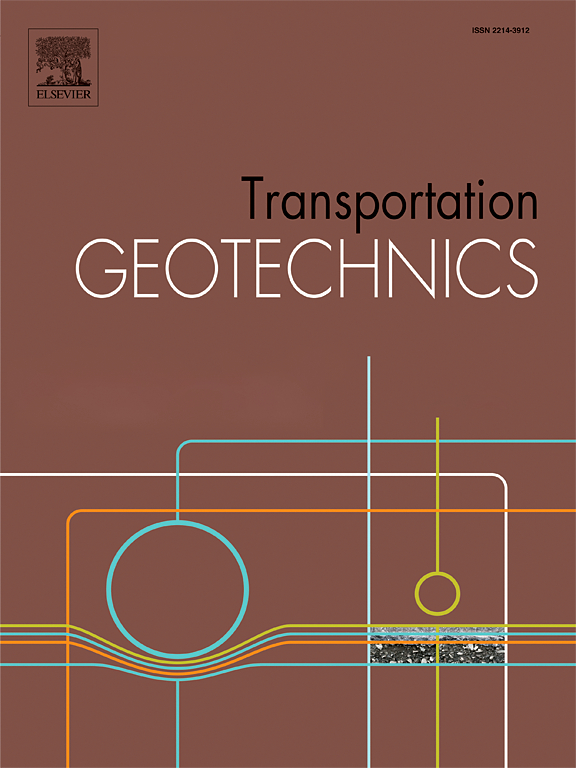Rutting performance prediction of flexible airfield pavements using nonlinear mechanistic models for asphalt and granular layers
IF 4.9
2区 工程技术
Q1 ENGINEERING, CIVIL
引用次数: 0
Abstract
The rutting performance of flexible airfield pavements is simulated by incorporating the permanent deformation of asphalt and granular layers. To achieve accurate predictions, airfield pavements are treated as a unified system, where the total rutting is the cumulative sum of the permanent deformation contributions from each layer.
A nonlinear viscoelastic-viscoplastic model is employed to simulate the response of the asphalt concrete layer, accounting for its time-dependent and plastic behavior. For the granular layers, a modified Drucker-Prager non-associative plasticity model with evolving hardening is utilized. The evolving hardening function captures the microstructural changes in granular materials under cyclic loading, enabling the model to represent the progressive increase in permanent deformation with repeated load applications.
These advanced constitutive models are implemented in the standalone PANDA-AP software (Pavement Analysis using Nonlinear Damage Approach: Airfield Pavements), specifically designed to predict the performance of airfield pavements. PANDA-AP is used to simulate the response of Construction Cycle 3 (CC3) test sections evaluated at the National Airfield Pavement Test Facility (NAPTF). Results demonstrate that PANDA-AP effectively predicts both the overall rutting and the layer-specific rutting behavior.
Finally, comparisons are presented between simulations conducted using PANDA-AP and those performed with FAARFIELD software, highlighting the capabilities and differences of these modeling approaches.

基于沥青和颗粒层非线性力学模型的柔性机场路面车辙性能预测
通过考虑沥青和颗粒层的永久变形,模拟了柔性机场路面的车辙性能。为了实现准确的预测,将机场路面视为一个统一的系统,其中总车辙是每层永久变形贡献的累积总和。采用非线性粘弹粘塑性模型模拟沥青混凝土层的响应,考虑了沥青混凝土层的时变特性和塑性特性。对于颗粒层,采用改进的Drucker-Prager演化硬化非联想塑性模型。不断演变的硬化函数捕获了循环加载下颗粒材料的微观结构变化,使模型能够表示重复加载作用下永久变形的逐步增加。这些先进的本构模型是在独立的PANDA-AP软件(路面分析使用非线性损伤方法:机场路面)中实现的,专门用于预测机场路面的性能。PANDA-AP用于模拟在国家机场路面测试设施(NAPTF)评估的施工周期3 (CC3)测试路段的响应。结果表明,PANDA-AP可以有效地预测整体车辙和特定层的车辙行为。最后,比较了PANDA-AP和FAARFIELD软件的模拟结果,强调了这些建模方法的能力和差异。
本文章由计算机程序翻译,如有差异,请以英文原文为准。
求助全文
约1分钟内获得全文
求助全文
来源期刊

Transportation Geotechnics
Social Sciences-Transportation
CiteScore
8.10
自引率
11.30%
发文量
194
审稿时长
51 days
期刊介绍:
Transportation Geotechnics is a journal dedicated to publishing high-quality, theoretical, and applied papers that cover all facets of geotechnics for transportation infrastructure such as roads, highways, railways, underground railways, airfields, and waterways. The journal places a special emphasis on case studies that present original work relevant to the sustainable construction of transportation infrastructure. The scope of topics it addresses includes the geotechnical properties of geomaterials for sustainable and rational design and construction, the behavior of compacted and stabilized geomaterials, the use of geosynthetics and reinforcement in constructed layers and interlayers, ground improvement and slope stability for transportation infrastructures, compaction technology and management, maintenance technology, the impact of climate, embankments for highways and high-speed trains, transition zones, dredging, underwater geotechnics for infrastructure purposes, and the modeling of multi-layered structures and supporting ground under dynamic and repeated loads.
 求助内容:
求助内容: 应助结果提醒方式:
应助结果提醒方式:


